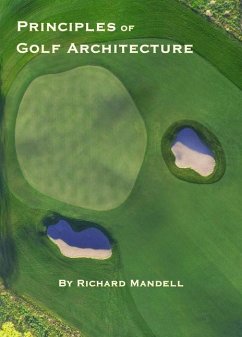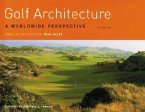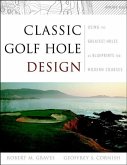Richard Mandell
Principles of Golf Architecture
Richard Mandell
Principles of Golf Architecture
- Gebundenes Buch
- Merkliste
- Auf die Merkliste
- Bewerten Bewerten
- Teilen
- Produkt teilen
- Produkterinnerung
- Produkterinnerung
The Principles of Golf Architecture intends to describe the details of the golf course design process as concisely as possible, first by defining both the Elements and Principles of Design in general terms and then relating these concepts to the art and science of golf architecture.
Andere Kunden interessierten sich auch für
![The Legendary Evolution of Pinehurst The Legendary Evolution of Pinehurst]() Richard MandellThe Legendary Evolution of Pinehurst63,99 €
Richard MandellThe Legendary Evolution of Pinehurst63,99 €![Golf Greens Golf Greens]() Michael J. HurdzanGolf Greens143,99 €
Michael J. HurdzanGolf Greens143,99 €![Golf Architecture Golf Architecture]() Golf Architecture43,99 €
Golf Architecture43,99 €![Golf Course Architecture Golf Course Architecture]() Michael J. HurdzanGolf Course Architecture138,99 €
Michael J. HurdzanGolf Course Architecture138,99 €![Classic Golf Hole Design Classic Golf Hole Design]() Robert Muir GravesClassic Golf Hole Design115,99 €
Robert Muir GravesClassic Golf Hole Design115,99 €![Ipm Handbook for Golf Courses Ipm Handbook for Golf Courses]() Gail L SchumannIpm Handbook for Golf Courses117,99 €
Gail L SchumannIpm Handbook for Golf Courses117,99 €![Turf Managers' Handbook for Golf Course Construction, Renovation, and Grow-In Turf Managers' Handbook for Golf Course Construction, Renovation, and Grow-In]() Charles B WhiteTurf Managers' Handbook for Golf Course Construction, Renovation, and Grow-In142,99 €
Charles B WhiteTurf Managers' Handbook for Golf Course Construction, Renovation, and Grow-In142,99 €-
-
-
The Principles of Golf Architecture intends to describe the details of the golf course design process as concisely as possible, first by defining both the Elements and Principles of Design in general terms and then relating these concepts to the art and science of golf architecture.
Hinweis: Dieser Artikel kann nur an eine deutsche Lieferadresse ausgeliefert werden.
Hinweis: Dieser Artikel kann nur an eine deutsche Lieferadresse ausgeliefert werden.
Produktdetails
- Produktdetails
- Verlag: T. Eliot Press
- Seitenzahl: 288
- Erscheinungstermin: 15. August 2022
- Englisch
- Abmessung: 232mm x 166mm x 21mm
- Gewicht: 807g
- ISBN-13: 9780979483646
- ISBN-10: 0979483646
- Artikelnr.: 68479159
- Herstellerkennzeichnung
- Libri GmbH
- Europaallee 1
- 36244 Bad Hersfeld
- gpsr@libri.de
- Verlag: T. Eliot Press
- Seitenzahl: 288
- Erscheinungstermin: 15. August 2022
- Englisch
- Abmessung: 232mm x 166mm x 21mm
- Gewicht: 807g
- ISBN-13: 9780979483646
- ISBN-10: 0979483646
- Artikelnr.: 68479159
- Herstellerkennzeichnung
- Libri GmbH
- Europaallee 1
- 36244 Bad Hersfeld
- gpsr@libri.de
Since Richard Mandell was fifteen years old, he has been captivated by the playing fields of the game of golf. Growing up surrounded by some of the greatest golf courses in the world, it was easy for him to fall under the spell. Winged Foot, National Golf Links of America, Bethpage Black and many others in New York shaped his early ideals and philosophies about the art of golf architecture. Since those halcyon days of his youth, Richard Mandell, ASGCA, has gone on to design more than 75 golf course projects of varying shapes and sizes in fifteen states and China. His firm, Richard Mandell Golf Architecture, has earned 31 different awards and accolades in four different decades of practice. In addition to being a golf architect, he is a licensed landscape architect, certified arborist, and accomplished writer. Richard is also a member of the USGA Museum Committee. Principles of Golf Architecture is Mandell's fourth book. He has also written numerous articles on golf architecture for magazines such as Golf Illustrated, Golf Course Architecture Magazine, Golf Digest India, and Links Magazine and has contributed chapters to four additional books on the subject: Volumes I and II of Golf Architecture (A Worldwide Perspective), Links to St. Andrews, and Favourite 53 3 07 Simply put, scale compares the size of an object in relation to ourselves and the world around us. Scale doesn't determine what is attractive or not but it will elicit feelings of comfort or burden. The result is one's observation that an object is either "in scale" or "out of scale" with its surroundings. How one describes what is in scale or out of scale is a subjective response based on personal feelings. In essence, objects that are considered in scale just look or feel right. When a reference is made to someone who has a "good eye," the inference is that the person, among other traits, can recognize objects which are in scale with each other and/or their surroundings. It's much easier to describe how something is out of scale. When an object is out of scale with the objects near it, that object is too big or too small in relation to the size of those objects. The object doesn't fit our established frame of reference. There are three generally-accepted terms for denoting the Element of Scale: Human Scale, Monumental Scale, and Shock Scale. All three scale types utilize the human form for distinction. Human Scale is used to design things for the physical and cognitive characteristics of humans. In other words, things are designed - whether they are spaces, vehicles, tools, or computers - so they can be understood and utilized at a level that relates to the limitations of a person. Human Scale balances the size of a space or object with the size of the user/viewer, allowing the user to feel comfortable more than anything else. Human Scale allows the users to feel themselves in agreeable proportion to what they see and hear so they share a sense of being related to the environment in a pleasing way. When comfort and assurance are desirable traits in a design process, Human Scale must be made evident. Scale - The size of an object relative to the size of the space in which it is located or other objects within that space. The Element of Scale Human Scale (Courtesy: Patrick Gainer) Monumental Scale (Courtesy: Patrick Gainer) Shock Scale (Courtesy: Patrick Gainer) Holes By Design: The Architect's Choice. His 2007 book, Pinehurst Home of American Golf (The Evolution of a Legend) won the 2008 International Network of Golf Book of the Year and was a finalist for the USGA Herbert Warren Wind Award as well as a ForeWord Magazine Sports Book Award 2007 Finalist.








